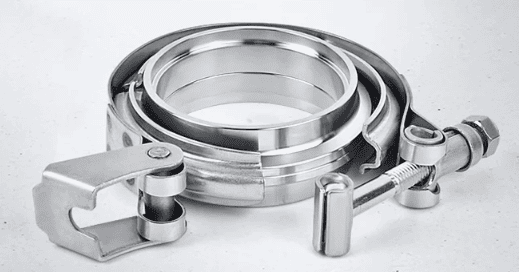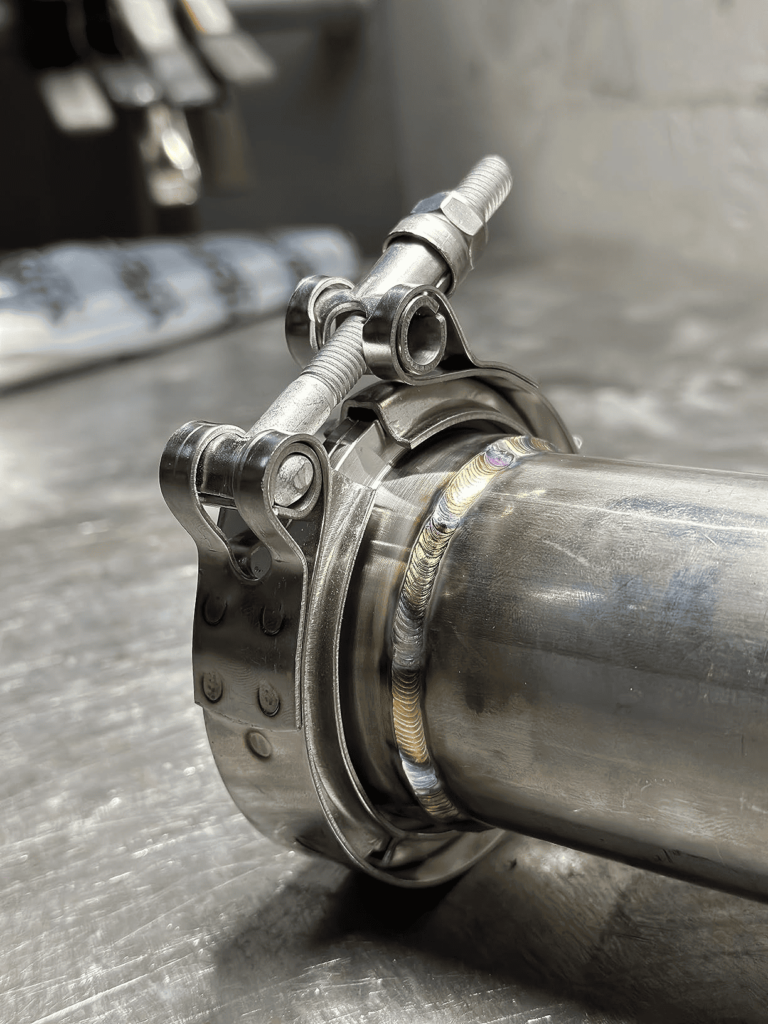V-Band-Klemmen haben viele Vorteile wie eine schnellere Installation und Entfernung, Keine Leckage, Hochdruckbeständigkeit, usw. Dieser Leitfaden führt Sie durch ihre Vorteile, Vergleiche, Professionelle Tipps und Installation im Detail.
A V-band clamp is a type of clamp used to create a strong seal between pipe connections. It consists of a V-shaped metal band and flanges. When you tighten the clamp’s nut, it squeezes the V-angle flanges together, applying even pressure all the way around the connection. This design eliminates the need for bolts or gaskets, which makes it great for high-vibration, high-heat applications like exhaust and turbo systems.
Let’s dig into how V-band clamps work and how to choose, install, usw.
How does the V-band work?
The V-band clamp system is made up of three main parts: two flanges (welded to the ends of the pipes) and the clamp. The flanges are shaped like a cone with a V in the middle. When you tighten the clamp nut, it pulls the flanges together. The V-angle causes the clamp to wedge together, creating even pressure all the way around and making a tight seal that won’t leak.
Because of the way it wedges together, it can handle a little bit of misalignment and vibration, which makes it perfect for automotive applications where things get hot and stressful.
Are V-band clamps good for exhaust?
You bet! V-band clamps are popular in performance and race exhaust systems because they:
Make it easy to take things apart and put them back together
Don’t require gaskets or sealant
Stay tight and in place even under high heat and vibration
Make a good, tight connection that looks clean
V-band systems are more reliable over time, especially in V-band exhaust and turbo setups, than band clamps or flanges.
What is a V-band turbo?
In a V-band turbo setup, the V-band clamp is used to connect the turbine housing to the downpipe or mid-pipe. This lets you swap turbos faster and eliminates problems like exhaust leaks at the turbo flange. It’s especially handy in tight engine bays where it’s hard to get a wrench on the bolts.
Bonus: V-band turbos usually let you rotate the housing 360°, which makes it easier to clock the housing.
How to install a V-band clamp
Weld both flanges to the pipe ends, making sure they are perfectly aligned.
Put anti-seize on the clamp nut, so it doesn’t gall.
Put the flanges together and put the clamp in.
Tighten the clamp nut evenly. Use a torque wrench to make sure it’s tight enough.
Check for leaks with smoke or soapy water.
Pros and cons of using V-band clamps
Vorteile
- Doesn’t leak under high pressure
- Easy to put together/take apart
- No gaskets needed
- Can rotate to get it lined up perfectly
Nachteile
- More expensive to start
- You have to weld it
- Can be overtightened and ruined
- If you don’t put it in right, it can come loose
Common V-band clamp mistakes and how to avoid them
- Overtightening: Strips threads or warps the clamp
- Undertightening: Causes leaks and loosening from vibration
- Misalignment of flanges: Prevents proper sealing and causes stress fractures
- No anti-seize: Makes removal a nightmare
Avoid these problems by taking your time and using a torque wrench.



